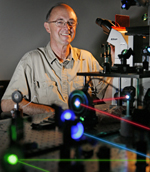Catalyst takes a close look at biological gadgets and nanomachines
Brandeis scientists dig deeply into the fertile terrain where materials science meets biology

Bob Meyer
It’s a common refrain among scientists that nature has taken her sweet time engineering some of her most essential and elegant creations: DNA, flagella, the cytoskeletal protein actin, and other cellular components with important jobs. “Billions of years,” goes the usual lament. Researchers, however, have no such luxury of time to figure out how nature has made the cellular universe run so smoothly, with most cellular machines lining up for duty in order, on time, and in the right shape.
A significant new research project at Brandeis is aimed squarely at taking a page out of nature’s bioengineering book. The goal is to create active nanomaterials that mimic nature’s cellular machines by moving in one direction or assembling in a predictable, uniform fashion, the way proteins do, to build cytoskeletal structures. Digging deeply into the fertile terrain where biology and materials science meet, the highly conceptual project will try to produce a new category of materials known as “active matter.” Distinct from normal inert materials, such as plastics and steel, active matter can move on its own and displays properties previously observed only in living materials, such as bacteria and other motile cells.
|
Download the fall 2009 |
Called the Materials Research Science and Engineering Center (MRSEC), the project involves more than a dozen researchers spanning biology, biochemistry, chemistry, and physics in a collaborative and interdisciplinary endeavor. With $7.8 million in funding from the National Science Foundation over six years, and with a possibility of renewal, the project is the jewel in the crown of biological physics at Brandeis. It also provides a multidisciplinary education to meet the needs of modern biological research and the biomaterials industry, and, through the Science Posse program, targets inner-city students in science.
“In general, we want to understand how biological cellular components are built out of materials, to learn how to engineer functional bio-mimetic nanosystems for important applications, such as biosensors and solar cells,” says physicist Bob Meyer, principal investigator on the project.
The center is taking a two-pronged strategy. In a bottom-up approach, the researchers are exploring how the addition of typical biological constraints, such as crowding and confinement, affect materials and their properties on the molecular level. For example, what happens to DNA when it is confined, or squished, into the tight quarters of a cell, where it cannot move around freely? Answers to basic questions like this will help the MRSEC team identify emergent properties, such as polymer segregation, that may be useful in developing new nanomaterials.
In a complementary top-down approach, the researchers are studying functioning cellular components, such as eukaryotic flagella or cilia. These are the specialized cellular subunits or organelles that miraculously move in synchronization to perform their jobs, like keeping the lungs clear of pollutants. Biologist Dany Nicastro is using electron microscopy to analyze the organization of the molecular motors in flagella that keep them beating in perfect harmony. The goal is to elucidate in detail the mechanism behind the mechanical motions of the flagella, a nifty little “biological gadget” whose malfunction is at the heart of many health conditions, including infertility.
“Flagella are living machines whose structure we can genetically modify to see how their mechanical properties and function are affected,” explains Nicastro.
The researchers are essentially reverse-engineering the function and structure of these biological gadgets to understand the laws governing self-assembly. The thinking is that if they can understand how these cellular machines put themselves together, already a great accomplishment, they may be able to change their function to create new nanomachines.
“Can we take these molecules and put them into a biological gadget that later can be an applicator for medicine?” asks Nicastro.
“This grant is confirmation that we’re one of the best places in the world to do this kind of science,” says Meyer.
Colleagues say Meyer's pioneering work in liquid crystals in the 1970s helped create the kind of interdisciplinary research environment the NSF lauded when it awarded fourteen MRSEC grants last fall—only five of them new—in a fierce national competition. In the current lineup of MRSECs, Brandeis, which won on its first try, is the smallest institution by far (about equal to CalTech), and sits in the company of Harvard, MIT, and Princeton.
As physicist Seth Fraden, a microfluidics expert responsible for reaching out to industry, says, “Whether it’s alive and crawling, or dead and inanimate, matter has to follow the laws of physics. We’re looking at the principles that govern biology to create new categories of materials.”
Take rod-like viruses, similar in shape to a billiard cue or pencil, albeit on a microscopic scale. Physicist Zvonimir Dogic studies how these particles assemble into complex membranes, twisted filaments, and even more complex objects. The shapes of these particles may be of use in developing more efficient, cheaper solar cells that don’t require silicon.
“One of our goals is to start with simple building blocks such as rod-like particles and learn the rules by which these particles assemble into complicated structures that might be of use,” explains Dogic.
In constructing the first carefully controllable example of active matter, the center is studying actin filaments, which propel themselves through space by getting longer at one end and shorter at the other in a process called tread-milling polymerization. One of their jobs is to provide cell motility.
“How do these moving filaments feel the presence of their neighbors in a large, organized array? How do they behave collectively? Are there rules? It’s not really clear how these organized systems of self-propelled filaments will behave, but we get hints of some possibilities from observing flocks of birds and schools of fish,” says Meyer. “Understanding the rules of behavior of this new kind of matter may help us understand processes like cell motility.”
“More than just a large grant, this puts Brandeis on the world map as one of the leaders in the exciting endeavor of combining physics and chemistry with the life sciences,” Fraden says.






